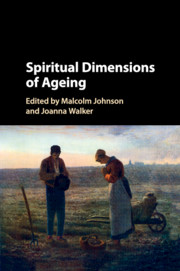Book contents
- Frontmatter
- Contents
- List of Contributors
- Preface
- Acknowledgements
- 1 Spirited Ageing
- Part I The Spiritual Journey of Ageing
- Part II Cultures of the Spirit in Modernity
- Part III Searching for Meaning in Later Life
- 10 Religion, Faith, Belief and Disbelief in Old Age: “A full-hearted evensong”
- 11 Finding Meaning and Sustaining Purpose in Later Life
- 12 Spirituality, Biographical Review and Biographical Pain at the End of Life in Old Age
- 13 Embracing Contraries: The Spiritual Quest as a Lifelong Process
- Part IV Meeting Spiritual Needs in Older Age
- Index
- References
11 - Finding Meaning and Sustaining Purpose in Later Life
from Part III - Searching for Meaning in Later Life
Published online by Cambridge University Press: 22 December 2016
- Frontmatter
- Contents
- List of Contributors
- Preface
- Acknowledgements
- 1 Spirited Ageing
- Part I The Spiritual Journey of Ageing
- Part II Cultures of the Spirit in Modernity
- Part III Searching for Meaning in Later Life
- 10 Religion, Faith, Belief and Disbelief in Old Age: “A full-hearted evensong”
- 11 Finding Meaning and Sustaining Purpose in Later Life
- 12 Spirituality, Biographical Review and Biographical Pain at the End of Life in Old Age
- 13 Embracing Contraries: The Spiritual Quest as a Lifelong Process
- Part IV Meeting Spiritual Needs in Older Age
- Index
- References
Summary
Introduction
My personal interest in the area of meaning and purpose in life is pastorally inspired and pastorally directed. During the second half of my fifty-year ministry I became increasingly fascinated by the evident resilience of church members, most of them women, in their seventies, eighties and nineties. I began to wonder what might be the source, or more likely the sources, of this resilience. I recognised that personality type could be a determinative factor – some by their very nature would be more vibrant than others. Life experience was also bound to play its part, for many of these impressive elders had worked in West Yorkshire woollen mills and other manual occupations in their earlier days, had lived through two world wars and had struggled to bring up large families in times of considerable adversity. They had fascinating life stories to tell and did so with real humanity and humour.
Most were sustained by a lively faith and by continued participation in the life of their church and community. Above all, they seemed to have retained, or discovered, a resilient sense of purpose. Then, when for seven years prior to my retirement, I served as pastoral director of Methodist Homes for the Aged (now MHA Care Group) I had the opportunity to meet many more such impressive individuals, including a remarkable number of centenarians. This background helps explain why, in my retirement, I chose to pursue a PhD study of well-being in some 500 older Methodists in the Leeds district where I reside, taking purpose in life as my focus or ‘dependent variable’ (Jewell 2007, 2010).
The sustaining of a sense of purpose in life appears to be one of the most significant factors in ensuring the mental, emotional and spiritual well-being and even, in some extreme circumstances, the physical survival of human beings throughout their lives. Paul Wong (2000, p. 24) regards personal meaning as the hidden dimension of successful ageing because ‘having a positive meaning and purpose in life will not only add years to one's life, but also life to one's years’. Wong, together with many other writers, appears to regard ‘meaning’ and ‘purpose’ as virtually interchangeable. However, Irvin Yalom (1980) argues that ‘meaning’ and ‘purpose’ have different connotations, the former referring to coherence – making sense of one's life thus far – and the latter to intention.
- Type
- Chapter
- Information
- Spiritual Dimensions of Ageing , pp. 179 - 197Publisher: Cambridge University PressPrint publication year: 2016
References
- 1
- Cited by

